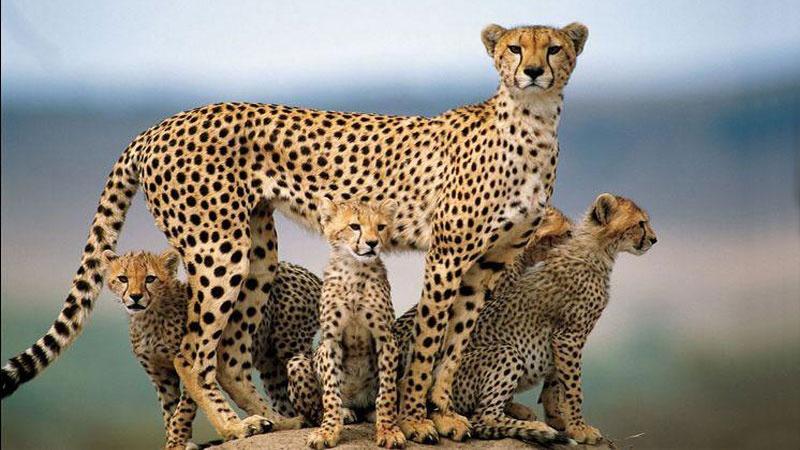Largest Wild Cats in the World

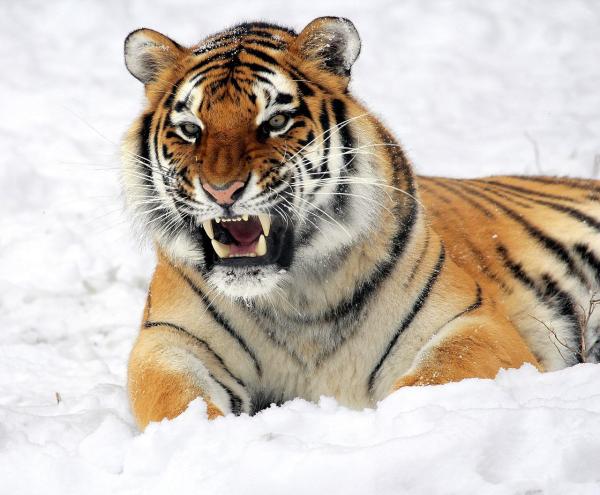
The term "big cat" is usually used to refer to all members of the genus Panthera. Small and medium-sized cats, including domestic cats, belong to the genus Felis. Big cats are found throughout the world in habitats as diverse as mangrove swamps, deserts, mountains and wooded forests. All cats are carnivores, and some are efficient apex predators. Overall, big cats are increasingly threatened by poaching, habitat loss, and other environmental factors.
In this AnimalWised article, we talk about the largest wild cats in the world and their conservation status.
1. Liger
The liger is a hybrid offspring of a male lion (Panthera leo) and a female tiger (Panthera tigris). In other words, the liger has parents from the same genus but from different species. The liger is different from the similar hybrid called the tigon, the hybrid offspring of a male tiger (Panthera tigris) and a female lion (Panthera leo).
Ligers are the largest of all known big cats. It is believed that the size of the liger is caused by the absence of certain growth-limiting genes1.
This large feline hybrid can reach over 1,000 pounds (ca. 454 kg) and is very muscular. They can grow up to 10 – 12 feet (3 to 3.66 m) tall standing on their hind legs and up to 4 1/2 feet tall at the shoulders. This makes them larger than male lions and tigers.
In general, tigers and ligers are larger than either of their parents and exhibit the characteristics of both animals in varying proportions. They like to swim, which is a characteristic of tigers, and are very social like lions.
Male ligers and tigrons are believed to be sterile in the vast majority of cases, if not all. However, females are occasionally capable of giving birth to cubs.
The liger is not considered an endangered species, although it is a rare animal. The reason for this is that it is a zoo-bred hybrid.
If you want to learn more about this hybrid species, do not miss the following article, where we explain the differences between ligers and tigons.
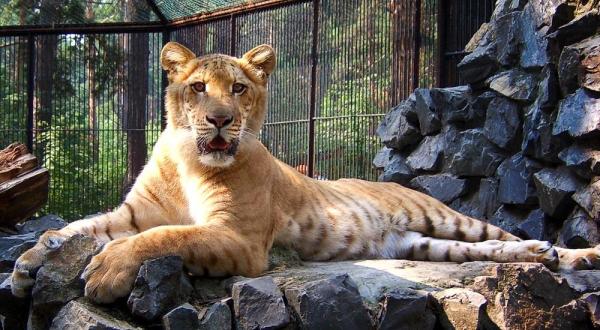
2. Siberian tiger
The Siberian tiger (Panthera tigris altaica) is a subspecies of tiger and is considered the largest cat in the world. It averages about 11 feet (ca. 335 cm) in length and has a tail of 3 feet (ca. 91 cm). Adult male Siberian tigers can weigh up to 700 lb. (ca. 318 kg)while females are much smaller at up to 400 lb. (ca. 181 kg).
Of all the big cats, the Siberian tiger is the only one that can survive in snow. It lives mainly in the birch forests of the Amur region in southeastern Russia, but also in parts of China and North Korea.
They are distinguished from other tigers by their striped coat, which is unique to each individual because they have fewer, lighter stripes and a thick mane that helps them stay warm. Like other tigers, they are solitary animals that can travel several miles a day in search of small prey such as rabbits, pike, and fish, as well as large mammals such as wild boar, elk, deer, and even bears. They also have extraordinary physical abilities: They are excellent swimmers, reach speeds of up to 50 mph (ca. 80 km/h), and jump up to 16 feet (ca. 5 m) high.
Siberian tigers are classified as endangered on the IUCN Red List. One cause of the dwindling population is habitat loss due to deforestation.
If you want to learn more about this tiger subspecies, you should not miss the following article, in which we explain the main differences between the Bengal tiger and the Siberian tiger, which are often confused with each other

3. Bengal Tiger
Bengal tigers (Panthera tigris tigris), inhabit tropical and subtropical forests and savannahs in Nepal, India, Burma, Bangladesh, and Tibet. Nearly one-third of the world's population of these big cats lives in Bangladesh and India, mainly in the national parks established for their protection.
It is also the most numerous tiger species and accounts for about half of the wild tiger population. They have also played an important role in Indian tradition and culture for many centuries.
Until recently, the Bengal tiger was considered the second-largest subspecies after the Siberian Tiger. However, some recent studies suggest that it may be the largest subspecies, with males in central India reaching up to 513 lb. (ca. 233 kg).
Bengal tigers are currently classified as endangered by both the IUCN. Their conservation status is very fragile due to the accelerated increase in human population. They are not only killed by poachers for their fur, body parts, and even for stuffing, but also on the grounds that they are a danger to humans.
Despite their fearsome reputation, most tigers avoid humans, although a few become dangerous man-eaters. They are usually sick or unable to hunt normally, or they live in an area where their natural prey has disappeared.
If you want to know more about the protection of the Bengal tiger, read this other article, where we explain in more detail all the reasons why the Bengal tiger is endangered.

4. Lion
The lion (Panthera leo) is a large cat of the genus Panthera, native to Africa and India.
It has a muscular, broad-chested body, a short, round head, round ears, and a tuft of hair at the end of the tail. It is sexually dimorphic; adult male lions are larger than females and have a distinct mane. Males grow up to 10 feet (ca. 3 m) long and have tails up to 3 feet (ca. 91 cm) long. They weigh between 330 and 550 pounds (ca. 149 to 249 kg). The slightly smaller females grow up to 9 feet (2.74 m) long and weigh between 265 and 395 lb. (ca. 120 to 179 kg).
Lions are the only big cats that live in groups called prides. These prides are family groups that can include up to three males, about a dozen females and their offspring. All the lionesses in a pride are related to each other, and the cubs usually stay with the group for their entire lives. Males defend the territory of the pride, which may cover 260 square kilometers of grassland, undergrowth, or sparse forest.
Lions are currently listed as endangered on the International Union for Conservation of Nature (IUCN) Red List of Threatened Species. In some parts of Africa, lions are listed as critically endangered as lion populations continue to decline at an unprecedented rate.
Lion populations have suffered shocking declines. In the last 120 years alone, they have disappeared from more than 90 percent of their historic range in Africa. In the last 25 years, their population has declined by nearly half.
Continue reading this other article if you want to know what are the main differences between a tiger and a lion.

5. Jaguar
The jaguar (Panthera onca) is a large cat species and the only living member of the genus Panthera native to the Americas. With a body length of up to 6 ft (ca. 183 cm) and a weight of up to 348 lb (ca. 158 kg), it is the largest cat species in the Americas and one of the largest in the world.
Most specimens have a light yellow to light brown coat covered with patches that blend into rosettes on the sides, although a melanistic black coat may also occur.
Proportionally, it has the largest skull of any predatory cat in the world. Its extremely strong jaws are capable of crushing the skull of an adult alligator and other mammal prey to deliver a fatal blow to the brain with one bite. They are also capable of piercing the shells of turtles. This, combined with its agility in and out of the water, makes it one of the world's deadliest predators in the world.
The jaguar is listed as near threatened on the International Union for Conservation of Nature (IUCN) Red List of Threatened Species. The jaguar is threatened by habitat loss and fragmentation, illegal killing in retaliation for livestock theft, and illegal trade in jaguar body parts. The jaguar population has likely declined by 20-25% since the mid-1990s.
If you want to learn more about this amazing predator, do not miss the following article, where we explain the main characteristics and differences between jaguar, leopard, and cheetah.
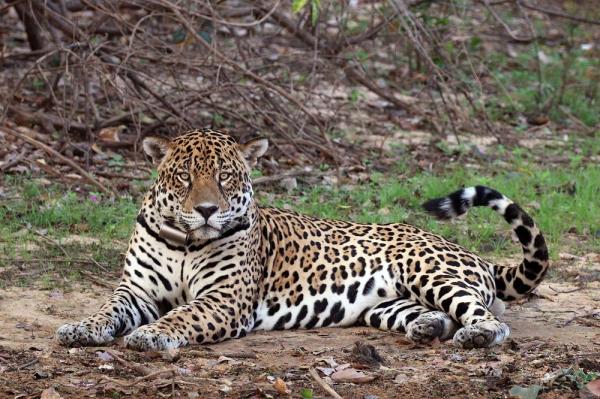
6. Cougar
The cougar (Puma concolor) is a large cat native to the Americas, belonging to the subfamily Felidae.
Its range extends from the Canadian Yukon to the southern Andes in South America, and it is the most widespread large terrestrial mammal in the Western Hemisphere. It is an adaptable, generalist species that occurs in most American habitats. In fact, the cougar will eat any animal it can catch, from insects to large mammals such as mule deer, white-tailed deer, elk, moose, mountain goat and bighorn sheep.
It is the second-largest cat in the New World, after the jaguar (Panthera onca). Males and females differ in size and weight, with males about 1/3 larger than females. Adult males can grow more than 3 ft (ca. 91 cm) long and weigh 135 to 175 pounds (ca. 60 to 79 kg). Adult females can grow up to 2.8 ft (ca. 85 cm) long and weigh between 90 and 105 pounds (ca. 40 to 48 kg).
Despite its size, the cougar is more closely related to smaller cats, including the domestic cat (Felis catus), than to any species in the Pantherinae subfamily.
The coat color of the cougar is uniform, meaning there is no color variation, but each individual has different colors. The fur can be golden, silver-gray, or reddish. Like almost all predatory cats, the cougar is a solitary animal. Only the mothers and their young live in groups.
The mountain lion has been classified as Least Concern by the International Union for Conservation of Nature (IUCN) since 2008, having been Near Threatened for the previous six years. Although the IUCN acknowledges that the global population of the mountain lion is likely declining, it has the largest geographic range of any land mammal in the Western Hemisphere.
If you want to learn more about cougars, do not miss the following article, where we explain all types of cougars.
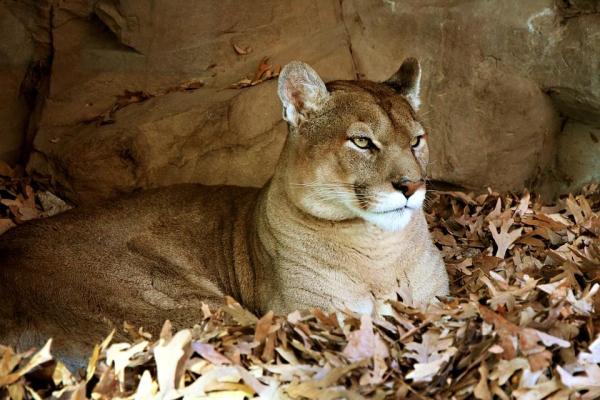
7. Leopard
The leopard (Panthera pardus) is one of the five existing species of the genus Panthera. It occurs in a large range in sub-Saharan Africa, some parts of western and Central Asia, southern Russia, and the Indian subcontinent as far south as southeast and East Asia.
Leopards are the smallest of the big cats. Female leopards weigh 46 to 132 lb. (ca. 20 to 60 kg) and males weigh 80 to 165 lb. (ca. 36 to 75 kg). Their shoulder height averages 28 in (0.71 m), but car reach up to 30.5 in (ca. 77 cm) tall.
The leopard is distinguished by its well camouflaged, rosette fur. Both leopards and jaguars, which are melanistic, are called black panthers.
Leopards are also known for their opportunistic hunting behavior, wide-ranging diet, strength, and ability to adapt to a variety of habitats from rainforest to steppe, including arid and mountainous regions. Their diet varies according to the availability of prey, ranging from strong-smelling carrion, fish, reptiles and birds to mammals such as rodents, hares, warthogs, antelopes, and baboons.
The leopard is listed as endangered in Central Asia and Sri Lanka and critically endangered in the Middle East, Russia, and the Indonesian island of Java. Leopards are often illegally killed for their skins and other body parts, which are highly sought after for ceremonial regalia throughout their range.
Continue reading this other article to learn more about the different types of leopards.
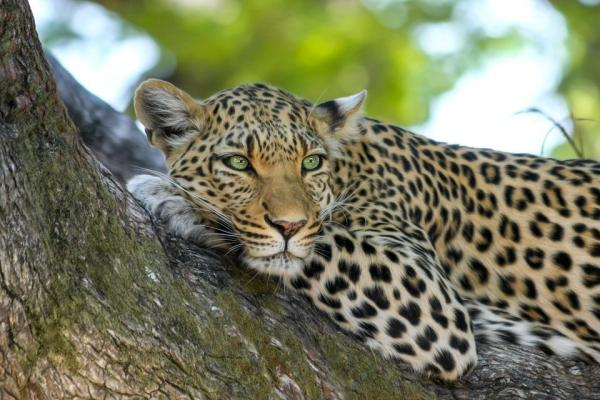
8. Cheetah
The cheetah (Acinonyx jubatus) is a large cat native to Africa and central Iran. Cheetahs are found in a variety of habitats, including the savannahs of the Serengeti, the arid mountains of the Sahara, and the hilly terrain of the Iranian desert.
Cheetahs are known for being incredibly fast. In fact, they are the fastest mammal on land and can reach speeds of 60 or perhaps even 70 miles (112.65 km) per hour over short distances. However, they usually hunt their prey at only about half that speed. Before feeding, a cheetah needs an hour and a half to recover from the hunt. Lightness, long, thin legs, and a long tail are some of the adaptations that make the cheetah fast.
Adult male cheetahs tend to be larger than females. Cheetah body length ranges from 3.6 to 4.9 ft (ca. 1.5 m), tail length ranges from 1.9 to 2.6 ft (ca. 60 to 79 cm), and shoulder height ranges from 2.2 to 3.1 ft (ca. 67 to 94 cm). Their weight averages 46 to 158 lb. (ca. 21 to 72 kg), with the average male being larger than the average female.
The cheetah is threatened by several factors, including habitat loss, conflicts with humans, poaching, and its high susceptibility to disease. The International Union for Conservation of Nature (IUCN) Red List of Threatened Species lists the cheetah as vulnerable. However, after a recent study found significant population declines, scientists are calling for the cheetah to be placed on the endangered species list.
You may be interested in this other article where we talk about where cheetahs live.

9. Snow Panther
The snow leopard (Panthera uncia), also known as the ounce, is a predator of the genus Panthera native to the mountain ranges of central and southern Asia.
The snow leopard has evolved to survive in the most extreme conditions on earth. Its gray and white fur with large black spots perfectly matches the structure of the rugged, rocky mountains of Central Asia. Thanks to its strong anatomy, the snow leopard can climb large, steep slopes with ease. Its hind legs give the snow leopard the ability to leap six times its body length. Its long tail provides balance and agility, and also allows the snow leopard to protect itself from the cold when resting.
The snow leopard reaches a length of about 7 ft (2.13 m), including its 3 ft (0.91 m). It is about 2 ft (ca. 61 cm) high at the shoulder and weighs from 50 to 90 lb. (ca. 23 to 41 kg).
It hunts at night and preys on a variety of animals, including marmots, wild sheep, ibex, and domestic livestock. Snow leopards actively pursue their prey up steep mountain slopes, using the momentum of their first jump to track animals up to 900 ft. They drag the prey to a safe place and consume all edible parts of the carcass.
The snow leopard is classified as endangered on the IUCN Red List, with the global population estimated at fewer than 10,000 adults. The greatest threat to snow leopard populations is poaching and the illegal trade in pelts and body parts. Where snow leopards hunt livestock, conflicts with humans occur. Loss of natural prey due to overgrazing by livestock, poaching, and defense of livestock are the main causes of snow leopard population decline.
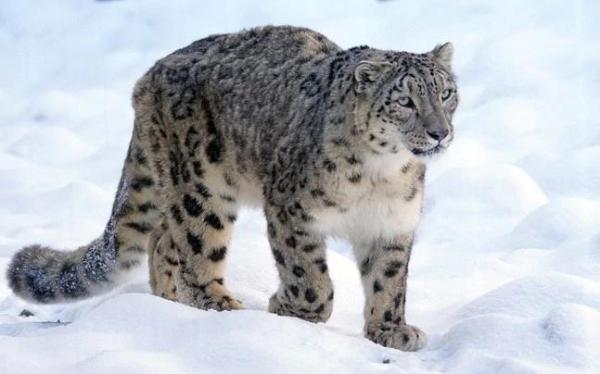
10. Eurasian lynx
The Eurasian lynx (Lynx lynx) is a medium-sized wild cat widely distributed from northern, central, and eastern Europe to central Asia and Siberia, the Tibetan Plateau, and the Himalayas. Unlike the other cats on this list, it belongs to the subfamily Felinae. It is the best known and largest lynx of this family of feline species.
The weight of an adult animal ranges from 40 to 80 pounds (ca. 18 to 36 kg) and its length ranges from 28 to 51 in (70 to 130 cm). The largest animals reach a shoulder height of 24-28 in (60-71 cm).
The Eurasian Lynx's strength comes from its legs. Their legs are very large and have membranes between their claws that are very similar to human snowshoes. Their body allows them to jump very high, and these movements make it easier for them to hunt. Their diet include rodents, rabbits, foxes, deer, and even wild boar. They usually prefer smaller prey, because it takes less energy to hunt them down, and there is no danger of being injured.
The Eurasian lynx, one of Europe's largest predators, has recovered from the brink of extinction in Europe, but is still critically endangered in some areas. It is currently classified as Least Concern by the International Union for Conservation of Nature (IUCN). The main threats to the Eurasian lynx are hunting and habitat loss. Although the population has benefited from the ban on legal international fur trade, illegal hunting is still a major threat.
If you want to know more about lynxes, do not miss the following article, where we describe all types of lynxes.
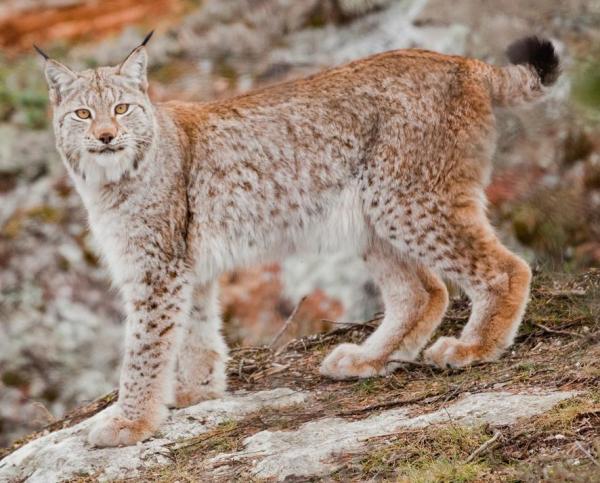
If you want to read similar articles to Largest Wild Cats in the World, we recommend you visit our Facts about the animal kingdom category.
- Bauer, H., Packer, C., Funston, PF, Henschel, P. & Nowell, K. 2016. Panthera leo (errata version published in 2017). The IUCN Red List of Threatened Species 2016: e.T15951A115130419.
- Breitenmoser, U., Breitenmoser-Würsten, C., Lanz, T., von Arx, M., Antonevich, A., Bao, W. & Avgan, B. 2015. Lynx lynx (errata version published in 2017). The IUCN Red List of Threatened Species 2015: e.T12519A121707666.
- Chundawat, RS, Khan, JA & Mallon, DP 2011. Panthera tigris ssp. tigers. The IUCN Red List of Threatened Species 2011: e.T136899A4348945.
- Durant, S., Mitchell, N., Ipavec, A. & Groom, R. 2015. Acinonyx jubatus. The IUCN Red List of Threatened Species 2015: e.T219A50649567.
- Quigley, H., Foster, R., Petracca, L., Payan, E., Salom, R. & Harmsen, B. 2017. Panthera onca (errata version published in 2018). The IUCN Red List of Threatened Species 2017: e.T15953A123791436.
- McCarthy, T., Mallon, D., Jackson, R., Zahler, P. & McCarthy, K. 2017. Panthera uncia. The IUCN Red List of Threatened Species 2017: e.T22732A50664030.
- Miquelle, D., Darman, Y. and Seryodkin, I. 2011. Panthera tigris ssp. Altaic. The IUCN Red List of Threatened Species 2011: e.T15956A5333650.
- Nielsen, C., Thompson, D., Kelly, M. & Lopez-Gonzalez, CA 2015. Puma concolor (errata version published in 2016). The IUCN Red List of Threatened Species 2015: e.T18868A97216466.
- Stein AB, Athreya V, Gerngross P, Balme G, Henschel P, Karanth U, Miquelle D, Rostro-Garcia S, Kamler JF, Laguardia A, Khorozyan, I. & Ghoddousi, A. 2016. Panthera pardus (errata version published in 2016). The IUCN Red List of Threatened Species 2016: e.T15954A102421779.
- Sawe, BE 2018. The World's Largest Big Cats. Available at: https://www.worldatlas.com/artic













